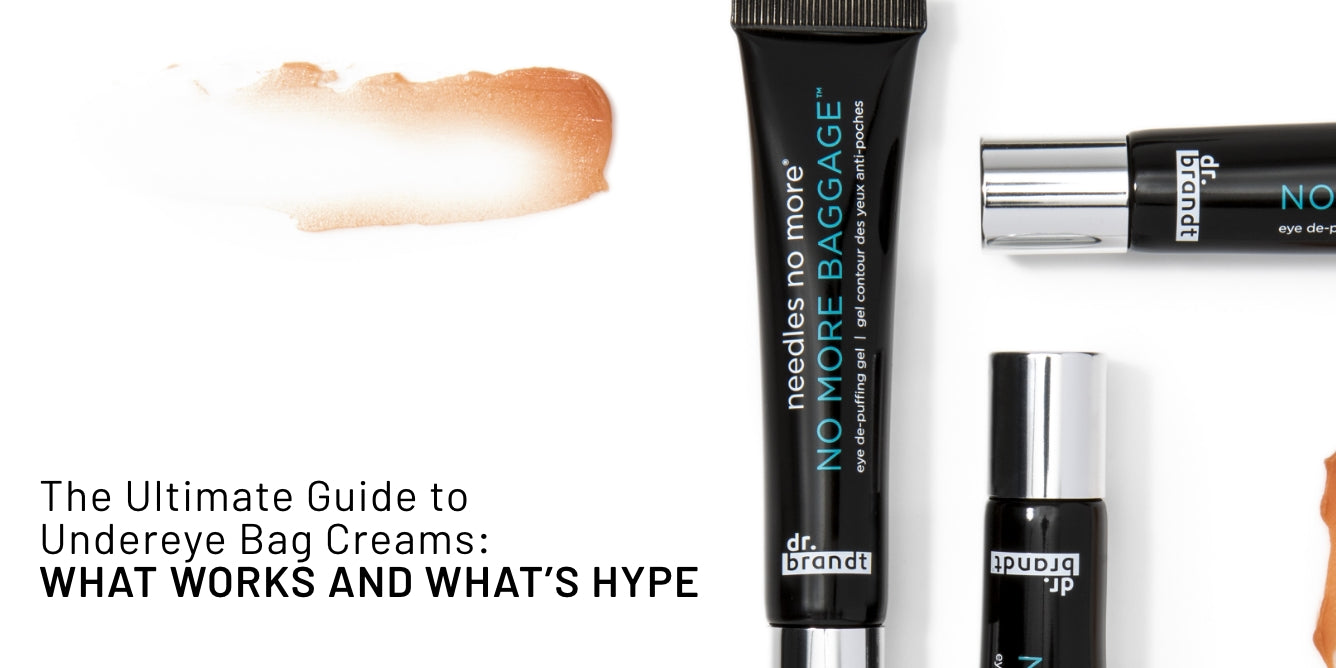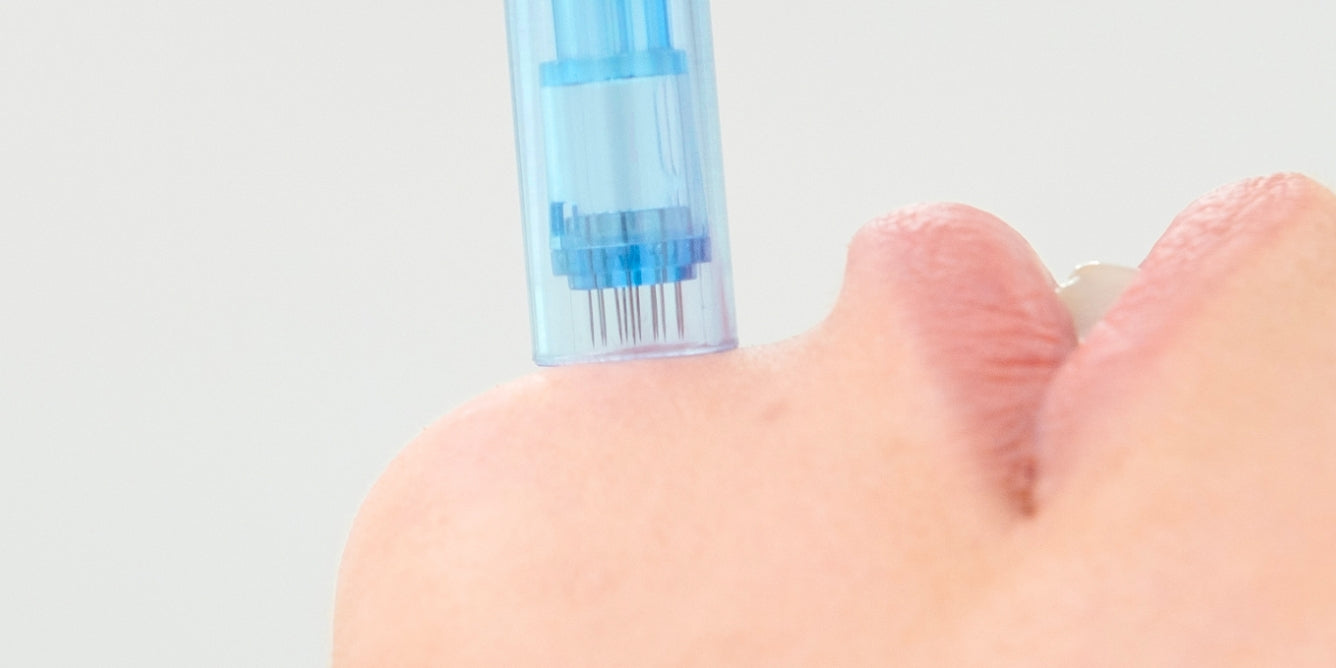
Seeing the term “pH balanced” on hair care and skin care products is probably not an uncommon sight to see nowadays. The question is, do we really understand what pH balance is, and why it’s important for us to be educated on the topic? Amandine Morel, our Director of Scientific Communication at Dr. BRANDT and Molly Knauer, registered dietician and member of our Skin Advisory Board help break down the basics of understanding the concept of pH balance.
By measuring pH (which stands for “potential of hydrogen”), you can determine how acidic or alkaline a given substance is. The scale goes from 0 - 14, with 7 being neutral. Water has a pH of 7. Anything below a 7 has greater acidity. Anything above 7 is considered alkaline.
Different elements and organisms carry different natural levels, and a neutral 7 isn’t necessarily equilibrium. Those levels vary even throughout your body:
- Your blood is slightly alkaline, with a pH between 7.35 and 7.45.
- Your stomach is very acidic, with a pH of 3.5 or below, so it can break down food.
- A normal vaginal pH level is between 3.8 and 4.5, which is moderately acidic. A pH level within this range can help to keep bacterial and fungal infections at bay.
- pH in your mouth should be 5.6 or above to help protect your gums and teeth.
- Your urine changes, depending on what you eat.
- Skin pH is slightly acidic, falling somewhere between 5-6 on the pH scale.
What is pH balance?
pH balance is the balance between the levels of acids and bases that is optimal for healthy body functioning. In fact, the body has to keep certain fluids, such as blood, consistently at a slightly alkaline state in order to maintain health. The lungs and kidneys play a key role in this process. If the lungs or kidneys are malfunctioning, the blood’s pH level can become imbalanced, and a disruption in the acid-base balance can lead to medical conditions such as infections for example.
The lungs control the body’s pH balance by releasing carbon dioxide, a slightly acidic compound. When you exhale, you’re expelling that carbon dioxide, a process that also helps regulate your body’s pH balance by reducing acidity. The amount of carbon dioxide you exhale is a function of how deeply you inhale or exhale. Your brain constantly monitors this in order to maintain the proper pH balance in your body.
The kidneys help the lungs maintain acid-base balance by excreting acids or bases into the blood. The kidneys’ effect on acidity works much more slowly than that of the lungs. Usually, the body maintains the pH of blood close to 7.40.
Everything you need to know about skin pH level
Know your natural skin pH Level
The acid mantle is a thin film on the skin’s surface composed of lipids from the oil glands mixed with amino acids from sweat and lactic acid. Along with the microbiome, it’s part of the delicate matrix that creates a healthy skin barrier. The acid mantle’s main job is to keep the good stuff (retain moisture) in, and the bad stuff (like bacteria, pollution, damaging UV rays) out.
Why is pH-balanced skin so important?
The acid mantle derives its name from the fact that the skin’s ideal pH is slightly acidic, about 5.5, and anything that can modify this pH can disrupt its ability to function optimally. A balanced skin is achieved when skin maintains the ideal pH of 5.5. At this slightly acidic pH, the skin is optimized to seal in hydration, while protecting us from free radicals, pollution, and environmental irritants. When skin is at an optimal pH level, it has improved barrier function, increased moisture retention, and less scaling. A slightly acidic skin pH helps normal (healthy) bacterial flora remain attached to the epidermis.
There's no easy way to test and check the pH balance of your skin, but some symptoms can give you a good idea:
- If the skin is inflamed, dry, irritated and overly sensitive, it might be suffering from a high pH (too alkaline). This high pH strips away the skin from its protective properties, and lead t premature skin aging and wrinkling, but also eczema, acne, irritant contact dermatitis, and fungal, yeast, and bacterial infections.
- If the skin pH is low (too acidic), skin will show signs of redness, irritation, oiliness, or increased acne.
A healthy skin with a normal pH appears smooth, soft without tightness, dryness, flaking, irritation or itching. It doesn’t react or become sensitive to skincare products that you use regularly.

The effects of pH levels on skin
What causes unbalanced skin pH?
The skin’s pH can be impacted by nearly anything. Anything that comes in contact with your skin - even the water you use to wash your face - has an effect on pH, whether positive or negative.
Unbalanced skincare products:The majority of skin care products are not pH balanced. Most cleansers, including bars and detergent soaps, tend to be too alkaline for the skin, as they strip away natural oils causing dryness and irritation. Skin that is too alkaline can be more susceptible to acne because a certain level of acidity is needed to inhibit bacterial growth on the skin. The flip side is also true. Be cautious with products that are too acidic and try to find a gentle cleanser or one that states it is pH balanced.
Washing your face too frequently:There is such a thing as “over cleansing.” Irritation, the feeling of tightness or dryness are classic signs of washing your face too much. In doing so, you’re likely stripping away natural oils that are produced by the body as the skin’s first defense barrier for external factors you encounter throughout the day. This makes the skin overcompensate and produce more oils, essentially leading to a vicious cycle of oiliness and dryness due to over cleansing.
Diet:Today, there is no direct correlation between what you eat and your skin pH level. However, this area of research is still undergoing extensive study. How diet could be a cause is in the form of allergies or hormone disruption, or just poor overall body health. What you eat affects everything in your body. If you eat a well-balanced diet, it likely isn't causing your skin problems. If, however your diet contains a lot of dairy, processed foods, sugar, etc., you could see improvement to your skin with a change in this type of diet that can lead to a healthier body in general.
Hormones:Hormones can also disrupt pH levels. Fluctuations of estrogen and progesterone lead to excess oil production, and having too much oil is disruptive as well. Also, around age 50 or about the time of menopause for women, pH levels start to change, becoming more neutral. As skin loses its acidity, it becomes more susceptible to environmental pollutants, free radicals, and bacterial growth, which all serve to disrupt skin pH even more.
Chemicals and toxins:Surfactants (mostly found in cleansers, shampoos, laundry detergent, and more) can completely deplete the skin of its natural oils, which serve as protection, and throw pH off balance. One of the most problematic being sodium lauryl sulfate, which is alkaline. Other surfactants like ethanolamines (DEA, MEA, and TEA) are incredibly disruptive, leading to skin toxicity and even hormone disruption. Such surfactants can be found in cleansers, laundry detergent, makeup, dry cleaning solvents, and more.
Other high-level threats to pH include antimicrobial chemicals known as triclosan and triclocarban. They’re used in products to fight bacteria. The reason they’re problematic is because the microflora (or bacteria) on our skin help regulate its pH.
Environmental factors like sun exposure, the change of seasons, and air pollution can also cause your skin’s pH to change. Because your face and hands are generally exposed to the elements more frequently than other parts of your body, they change pH levels at a greater rate than those protected areas. That’s why the irritation is typically contained to those locations rather than spread across your entire body.
How do you know if your pH balance is off?
If your skin is too red, too dry, too itchy, too flaky, too oily—too anything—it’s potentially because the ideal balance of the skin is off and the pH has shifted, creating a cascade of inflammatory factors and unevenness in the natural flora.
Skin issues like eczema, redness, dry patches, acne, oiliness, psoriasis, and premature signs of aging all indicate that your skin’s pH is off-balance. That means your skin’s barrier is damaged. A recent study published in the British Journal of Dermatology found that, over eight years, women with more alkaline skin experienced a greater number of fine lines and crow’s feet than those with a more acidic balance.
When your skin is out of balance, it can’t perform normal functions like healthy self-exfoliation. Instead of shedding dead skin cells, it goes into protective mode and holds onto them, and that’s the dry skin process.
A pH that is too alkaline causes drying and decreased hydration of skin, leading to eczema flares and potentially premature signs of aging (like fine lines, wrinkles), while skin being too acidic creates increased redness and inflammation.
How to get your pH balance back to normal?
To correct your skin pH level, you need to bring the skin barrier function back to its optimal state of equilibrium. Below are a few solutions to take into consideration.
-
Eliminate harsh ingredients and soaps (alkaline).
The first step is eliminating harsh ingredients and alkaline soaps (like bar soaps) that strip the skin of oils. Washing with soap raises our skin’s pH by at least one point, and it can take hours to get back down to 5.5. -
Removechemicals and toxins that could harm your skin.
Check the labels of your common household goods like dishwasher fluid, detergents, cleaning and cleaning supplies, as well as your make up, shampoo/conditioner and skincare to ensure they don’t contain -
Switch to pH balanced skincare products.
Going back to basics (with pH-balanced products) for a few weeks can calm skin problems. Your skin will then appear healthier overall. It will look and feel adequately moisturized and have a healthy glow. Once balance is restored, your other products will work better too. You want to apply your moisturizers to a surface of the right pH so they can actually work. -
Uselukewarm water to rinse your face.
That tightness you feel after a nice long scrub? That’s skin’s response to its protective layer being stripped away. Use lukewarm water and focus on getting a good rinse instead. -
Put away the washcloth
They are too abrasive for the face, especially the gentle skin on the cheeks. Your hands or a gentle cleansing brush work just fine. -
Use products with active ingredients
Look for clinically proven products that contain vitamins and antioxidants to promote cell turnover: pomegranate, green tea, vitamin A (retinols), etc.
What helps your pH balance?
Registered Dietician and Skin Advisory Board Member, Molly Knauer, helps us understand how our diet affects our pH levels.
Our skin and body both thrive at a certain pH level. While our body will naturally maintain its normal pH level (blood's pH level stays between 7.35-7.45), our lifestyle and diet choices can make it easier or tougher for our body and our skin to maintain that optimal pH level.

Our clear skin diet :
When we eat highly acidic foods such as sugar, red meat and refined carbohydrates, our body has to work extra hard to maintain that optimal pH. Often, an imbalanced or acidic gut microbiome will be reflected in our skin with redness, puffiness or breakouts. Fueling our gut microbiome with lots of leafy greens, fruits and fibrous vegetables, healthy fats, and foods high in prebiotics, it allows our gut and our body overall to operate smoothly with less overall effort. When we have to use up less of our energy for digestion, we will feel more alert, energetic and clear. Limiting the inflammatory and acidic foods can also allow for clearer, brighter, younger looking skin.




Leave a comment (all fields required)